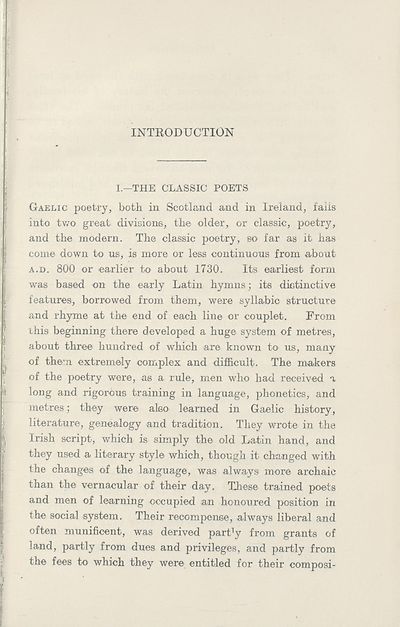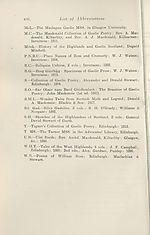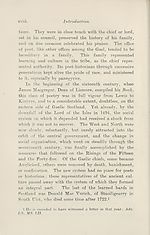Download files
Complete book:
Individual page:
Thumbnail gallery: Grid view | List view

INTRODUCTION
I.—THE CLASSIC POETS
Gaelic poetry, both in Scotland and in Ireland, falls
into two great divisions, the older, or classic, poetry,
and the modern. The classic poetry, so far as it has
come down to us, is more or less continuous from about
a.d. 800 or earlier to about 1730. Its earliest form
was based on the early Latin hymns; its distinctive
features, borrowed from them, were syllabic structure
and rhyme at the end of each line or couplet. From
this beginning there developed a huge system of metres,
about three hundred of which are known to us, many
of them extremely complex and difficult. The makers
of the poetry were, as a rule, men who had received a
long and rigorous training in language, phonetics, and
metres; they were aleo learned in Gaelic history,
literature, genealogy and tradition. They wrote in the
Irish script, which is simply the old Latin hand, and
they used a literary style which, though it changed with
the changes of the language, was always more archaic
than the vernacular of their day. These trained poets
and men of learning occupied an honoured position in
the social system. Their recompense, always liberal and
often munificent, was derived part1y from grants of
land, partly from dues and privileges, and partly from
the fees to which they were entitled for their composi-
I.—THE CLASSIC POETS
Gaelic poetry, both in Scotland and in Ireland, falls
into two great divisions, the older, or classic, poetry,
and the modern. The classic poetry, so far as it has
come down to us, is more or less continuous from about
a.d. 800 or earlier to about 1730. Its earliest form
was based on the early Latin hymns; its distinctive
features, borrowed from them, were syllabic structure
and rhyme at the end of each line or couplet. From
this beginning there developed a huge system of metres,
about three hundred of which are known to us, many
of them extremely complex and difficult. The makers
of the poetry were, as a rule, men who had received a
long and rigorous training in language, phonetics, and
metres; they were aleo learned in Gaelic history,
literature, genealogy and tradition. They wrote in the
Irish script, which is simply the old Latin hand, and
they used a literary style which, though it changed with
the changes of the language, was always more archaic
than the vernacular of their day. These trained poets
and men of learning occupied an honoured position in
the social system. Their recompense, always liberal and
often munificent, was derived part1y from grants of
land, partly from dues and privileges, and partly from
the fees to which they were entitled for their composi-
Set display mode to:
![]() Universal Viewer |
Universal Viewer | ![]() Mirador |
Large image | Transcription
Mirador |
Large image | Transcription
| An Comunn Gàidhealach > An Comunn Gàidhealach Publications > Bàrdachd Ghàidhlig > (21) |
|---|
| Permanent URL | https://digital.nls.uk/126455270 |
|---|
| Description | This contains items published by An Comunn, which are not specifically Mòd-related. It includes journals, annual reports and corporate documents, policy statements, educational resources and published plays and literature. It is arranged alphabetically by title. |
|---|
| Description | A collection of over 400 items published by An Comunn Gàidhealach, the organisation which promotes Gaelic language and culture and organises the Royal National Mòd. Dating from 1891 up to the present day, the collection includes journals and newspapers, annual reports, educational materials, national Mòd programmes, published Mòd literature and music. |
|---|---|
| Additional NLS resources: |
|

